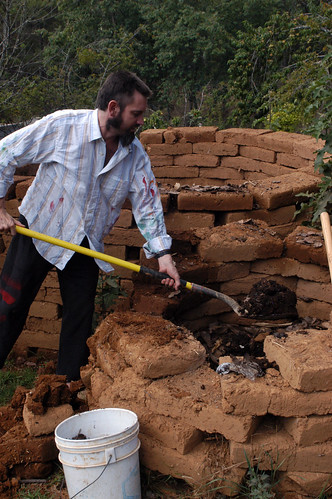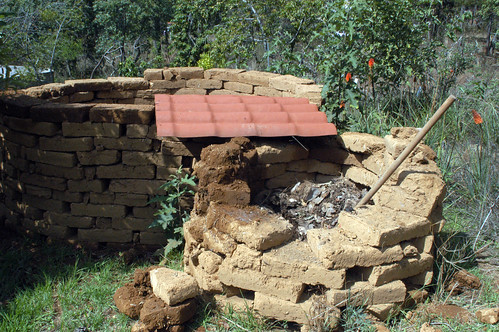We have red wigglers! If you look closely at the photo below, you can see a couple of our worms; it was difficult to get a good picture because the worms immediately crawl back into the dirt to hide from the sun.
About a year ago a nearby permaculture farm gave us a few red worms (eisenia foetida). We tossed them into our kitchen waste compost bin and, until last week, forgot about them.
We were very pleased to discover that they had reproduced wildly! Turning the dirt over in our compost bin revealed hundreds of worms, happily munching away at our kitchen waste. This species of worm is adapted to the environment of decaying organic material, and thrive in rotting vegetation, compost, and manure (see wikipedia for more information). Using worms to aid in composting is known as vermiculture, or vermicompost.
The worms work so well because they eat waste and excrete a richer soil. They aid and speed up the composting process immensely. We’ve distributed the worms to several locations at the Bosque. We added them to our larger kitchen compost bin, the small Casita bin, the Casita composting toilets, the studio toilets, and the View toilets. By adding the worms to the composting toilets, as the first stage of humanure compost completes, the worms can finish the job, making a far healthier compost.
We do not attempt to be extremely efficient in our composting processes because we have both space and time.
For those with small yard, there is a rush with caring for, mixing, and turning compost bins. We’re not in a rush; we can let the natural composting processes as well as the worms do their job, and the kitchen waste will simply go away! For this reason we rarely turn or give special attention to our worm bins, much to the distress of occasional crazy-about-compost volunteers and visitors. We will use the compost in our gardens, and the main compost bin is located in the orchard and provides nutrients to our avocado and peach trees. Our compost bins are made out of adobe blocks, and we put roofing pieces over parts of the bins to try to keep a good balance of moisture.
As we have a surplus of the worms, we will give them to our friends in neighboring villages with brief instructions on how to have a worm bin.



Bonjour !
Pouvez-vous m’indiquer avec précision la marche à suivre pour un “lombripostage” de toilettes sèches.
Je reprends un gîte de montagne le mois prochain. Les toilettes dégagent une odeur nauséabondes…. Normal me direz-vous puisque seul un bac de récupération est là pour accueillir les déjections humaines des clients.
D’après vous qui s’emblez bien connaître (ouf) puis-je m’appuyer sur les lombrics pour assainir ?
Sinon existe t il des micro organismes qui pourraient aussi m’aider
J’attends votre réponse !!!
Merci 1000 fois
Michèle